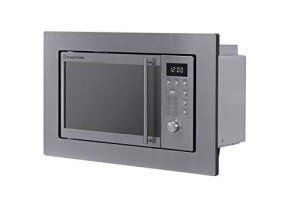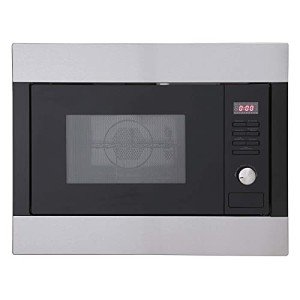Why Nobody Cares About Microwave Built
페이지 정보

본문
 How is a Microwave 25 litre built in microwave?
How is a Microwave 25 litre built in microwave?Microwave ovens have taken household convenience to a whole new level. They are designed to fit in cabinets on the walls or over kitchen islands. They are made from a variety of materials.
The cavity magnetron tube emitting microwaves was invented in 1940 at Birmingham University in England. Percy Spencer realized that this device could heat food when he observed eggs and corn pop cook.
Raw Materials
Microwave (MW), heating is growing in popularity in the material processing industry because of its inherent advantages like speedier heating and uniform heating. Its non-contact nature and energy efficiency, and quicker heating are other advantages. Heating with MW can be applied on a wide range of engineering materials, including metals, ceramics and polymers. Recently, it was modified to bulk metal joins, making dissimilar metallic powders clad on metallic substrates and casting.
The main raw material for microwave ovens is metal which is extracted from the earth through extraction and mining processes that consume huge amounts of energy and create greenhouse gases. The other key material is plastic, which is derived from organic substances that are natural like crude oil and cellulose. The manufacturing of plastic produces indirect greenhouse gas emissions from the use of fossil fuels to produce electricity and heat, as well as direct emissions from chemical processing, for example the production of phthalates and bisphenol A.
After the raw materials are acquired, they are subjected to an extensive process of manufacturing and quality control to ensure they are in compliance with federal regulations. In this process, a wide range of emissions and waste are produced, such as oil, solvents dust, fumes and dust. The final product is shipped to retailers, and then to consumers. The majority of microwaves are shipped via truck. This consumes lots of energy and creates greenhouse emissions.
When you purchase a microwave, it will often be used for several years until it becomes outdated and removed. Microwaves last a limited time therefore recycling and disposal options are essential to reduce emissions and waste.
Design
Microwave ovens cook food by emitting electromagnetic waves within the microwave region (300 MHz to 300 GHz). The radiation travels through the microwave oven and cooks the food. Microwave ovens are designed to prevent harmful effects from the radiation, like the arcing of radiation that can damage the oven as well as the food it contains. There are various types of microwave ovens on the market, each with distinct advantages and disadvantages. When selecting a microwave oven take into consideration the size of your kitchen and the size that will meet your cooking needs. If you are limited in counter space you may want to consider a built in microwave oven-in model that hides the appliance.
The process of designing microwaves begins with the acquisition of raw materials which are then processed to create the various parts of the oven. This includes the oven's frame and cavity, the turntable, glass tray, magnetron tube (with capacitor and transformer), diode, waveguide, and electromechanical components (motors, relays, switches). The casing is usually constructed of metal, such as galvanized stainless steel integrated microwave, aluminum, or brass.
After assembly after which the microwave is checked and then packaged to be delivered. The packaging is typically made of recycled materials, such as cardboard and paper or recyclable plastics like polyethylene terephthalate and polyvinylchloride.
The new microwaves are loaded onto transport tools like planes, ships or automobiles. These tools use fossil fuels to convert chemical energy into mechanical energy which is used to move the microwaves on their way to the customers. Once the microwaves are delivered, they are plugged into the system and consumed by customers. This is the energy-intensive phase of the life cycle, and produces emissions such as carbon dioxide.
Manufacture
Microwave ovens are among the most popular appliances in modern kitchens. What makes a microwave work? Let's examine how to assemble this staple of the home.
Metals, plastic parts, and other electrical components are the raw materials required for the production of microwave. Some of these materials can be found in the earth, but others require processing. The manufacturing process is energy-intensive, which results in greenhouse gas emission. The impact on the environment of microwaves is in large part because of this stage of production.
In the manufacturing stage most of the material is assembled by automated machines. A large part of the assembly takes place in a factory in which workers operate on conveyor belts. Workers use a machine shape sheet metal into the door and outer case. After the frame has been made it is washed with an alkaline cleaner to get rid of dirt and oil. It is then assemble with screws and bolts to create a safe chassis for the inner cavity.
After the chassis is constructed the magnetron and the other components are installed. The magnetron emits microwaves which causes water molecules to increase in temperature. During this phase there are risks to safety like the possibility that plasticizers will be released into food items or the oven may explode if it is empty.
Once the microwave is fully assembled, microwaves built In it is subjected to rigorous tests and inspections to ensure that it meets federal standards. After this step the microwave is packed to be distributed to customers. Transporting microwaves from the manufacturing facility to retailers is an environmental burden. The equipment used to transport and deliver the microwaves use fossil fuels that release carbon dioxide and other greenhouse gases into the atmosphere.
Testing
Microwaves are electromagnetic radiation that forms part of the electromagnetic spectrum of waves. The spectrum is made up of different forms of energy that travel through space. They include visible light, radio waves, infrared radiation, and ultraviolet radiation. Microwaves are able to heat food through the process of microwave heating, which uses electromagnetic radiation to cause the water molecules in the food to rotate and vibrate. This causes food to be heated, without heating the surrounding air or changing the physical structure of the food.
Microwaving is a safe way of heating food since the microwave radiation doesn't affect the cells in the food or cause them to become radioactive. However, those with pacemakers should stay clear of microwaves as the radiation could interfere with the electrical signals from certain electronic cardiac devices. This problem has been solved by using a special shielding.
Certain chemicals used in microwave ovens can be harmful to health, such as bisphenol A (BPA) and phthalates. BPA has been found to leach into food items from plastic containers, and phthalates can be associated with increased risk of reproductive problems. Microwave radiation may also harm eye tissues and cause cataracts.
In today's NOPR, the test procedures require that microwaves be tested in their microwave-only cooking mode as well as convection microwave cooking modes to assess the energy consumption of appliances under typical conditions of use. The test procedure uses a mixture of water and ingredients from food that are designed to replicate the food items that would be reheated in the microwave. The mixtures are then poured into a borosilicate-glass container, heated up in the microwave, and measured for thermal efficiency.
Packaging
Many microwave-ready meals employ special packaging techniques known as modified atmosphere packing (MAP). This method of packaging utilizes oxygen-eliminating gases to prolong the shelf life of pre-prepared food items. These gases are usually made from carbon dioxide, pure oxygen, and nitrogen, and operate by removing oxygen from the food's surroundings. This helps prevent spoilage and just click the next post increases the shelf life of the food for the consumer.
The MAP process can also be used for meat products, such as frozen chicken wings, frozen steaks, or beef patties. These packages are made of a nonwoven film, which absorbs moisture and helps to keep the food moist and fresh for longer. This kind of packaging reduces waste since it reduces the amount of air and water that are lost in the heating process.
 When deciding on a microwave, consumers must take into consideration the size and power level, as well as other features, like defrost settings, or sensor cooking. These features can help make cooking more comfortable, but it's also important to consider how often they will be used in order to avoid purchasing a microwave with additional functionality that will remain in use for the majority of the time. The style of the microwave is a further consideration, as some models come with a flush-best built In combination Microwave oven design that fits seamlessly into cabinetry that is already in place.
When deciding on a microwave, consumers must take into consideration the size and power level, as well as other features, like defrost settings, or sensor cooking. These features can help make cooking more comfortable, but it's also important to consider how often they will be used in order to avoid purchasing a microwave with additional functionality that will remain in use for the majority of the time. The style of the microwave is a further consideration, as some models come with a flush-best built In combination Microwave oven design that fits seamlessly into cabinetry that is already in place.- 이전글شركة تركيب مطابخ بالرياض عروض 35 % 25.02.01
- 다음글10 Things Everyone Has To Say About Birth Injury Advocate Birth Injury Advocate 25.02.01
댓글목록
등록된 댓글이 없습니다.
